Slope mass rating and kinematic analysis of slopes along the national highway-58 near Jonk,Rishikesh,India
Tariq Siddique,M.Masroor Alam,M.E.A.Mondal,V.Vishal
aDepartment of Earth Sciences,Indian Institute of Technology Roorkee,Roorkee,247 667,India
bDepartment of Geology,Aligarh Muslim University,Aligarh,202 002,India
cDepartment of Civil Engineering,Aligarh Muslim University,Aligarh,202 002,India
Full length article
Slope mass rating and kinematic analysis of slopes along the national highway-58 near Jonk,Rishikesh,India
Tariq Siddiquea,b,M.Masroor Alamc,M.E.A.Mondalb,V.Vishala,*
aDepartment of Earth Sciences,Indian Institute of Technology Roorkee,Roorkee,247 667,India
bDepartment of Geology,Aligarh Muslim University,Aligarh,202 002,India
cDepartment of Civil Engineering,Aligarh Muslim University,Aligarh,202 002,India
A R T I C L E I N F O
Article history:
Received 28 January 2015
Received in revised form
18 June 2015
Accepted 23 June 2015
Available online 4 August 2015
Slope mass rating(SMR) Kinematic analysis Landslide susceptibility score(LSS) Vulnerability to landslide
The road network in the Himalayan terrain,connecting remote areas either in the valleys or on the hill slopes,plays a pivotalrole in socio-economic development of India.The planning,development and even maintenance of road and rail networks in such precarious terrains are always a challenging task because of complexities posed by topography,geological structures,varied lithology and neotectonics.Increasing population and construction of roads have led to destabilisation of slopes,thus leading to mass wasting and movement,further aggravation due to recent events of cloud bursts and unprecedented fl ash fl oods. Vulnerability analysis of slopes is an important component for the“Landslide Hazard Assessment”and“Slope Mass Characterisation”guide planners to predict and choose suitable ways for construction of roads and other engineering structures.The problem of landslides along the national highway-58(NH-58)from Rishikesh to Devprayag is a common scene.The slopes along the NH-58 between Jonk and Rishikesh were investigated,which experienced very heavy traf fi c especially from March to August due to pilgrimage to Kedarnath shrine.On the basis ofslope mass rating(SMR)investigation,the area falls in stable class,and landslide susceptibility score(LSS)values also indicate that the slopes under investigation fall in low to moderate vulnerability to landslide.More attentions should be paid to the slopes to achieve greater safe and economic bene fi ts along the highway.
?2015 Institute of Rock and Soil Mechanics,Chinese Academy of Sciences.Production and hosting by Elsevier B.V.All rights reserved.
1.Introduction
Himalayan orogeny is the result of collision of Indian and Eurasian plates.This zone is extensively deformed,having major thrust faults as discontinuities,such as Himalayan Frontal Thrust (HFT),Main Boundary Fault(MBT)and Main Central Thrust(MCT). Landslide along the nationalhighway-58(NH-58)in the Himalayan terrain is a very common and frequent naturaldisaster,causing loss of life and property.Slopes along this highway failed many times at different locations and have become more vulnerable to sliding due to unplanned development,as witnessed during the Uttarakhand hazard.The hillslopes in Lesser Himalayas are wellknown for their instability due to the dynamic nature of slopes,geomorphology, snowfall,heavy and sustained rainfall,and ongoing neotectonic activity.Increasing anthropogenic activities in recent years appear to be an additional factor for instability of slopes in the Himalayan terrain.There are many major or minor landslides that happened at different places(Sati et al.,2011).Unplanned excavation and vibrations caused by blasting along the NH-58 near Badarinath and Rishikesh for construction and road widening project during last few years have enhanced the vulnerability of slopes to landslide. Stability studies of road cut slopes in Rudraprayag area have identi fi ed critical slopes at certain locations by numerical simulation with the factor of safety(FOS)less than 1(Singh et al.,2008).For safer construction and reducing slope failure,proper investigations and slope characterisation are required.The analysis of slope characterisation depends upon many parameters and database related to slope,rock mass,meteorology,etc.(Pradhan et al.,2011, 2014;Trivedi et al.,2012).Stability studies were conducted for 50 road cut slopes using rock mass rating(RMR)and geological strength index(GSI)classi fi cation systems in the region of Garhwal Himalayas to identify the vulnerable slopes along the NH-58 (Sarkar et al.,2012a).Rishikesh has an average elevation of 372 m (1745 ft).According to the latest weather update by Skymet Meteorology Division in India,the temperature is around 20°C-22°C. According to the Koppen-Geiger climate classi fi cation system, Rishikesh lies in humid to sub-tropical area.Rainfall in Rishikeshvaries signi fi cantly in differentseasons;the maximum precipitation happens from July to September with the magnitude of approximately 490 mm,while the minimumprecipitation up to 10 mmcan be seen in April.Slope mass characterisation is necessary for geotechnical studies,which is based on different parameters of rock/rock mass,aiming to classify a terrain into different kinds of slope classes and also their vulnerability to landslide,so that corresponding support measures can be proposed.The quanti fi cation of all the intrinsic properties of rock mass and external factors acting on the slope can be used to illustrate the present condition of slopes and to predict their behaviours in future.
The NH-58 is the lifeline for the people living in the cities of Rishikesh,Devaprayag,Srinagar,Rudraprayag,Gochar,Chamoliand Joshimath.Severalcases of obstructions due to landslides along the road were reported and created lots of dif fi culties to travellers and pilgrims.This investigation was carried out to identify the safe zones and the areas affected by the geo-hazards,their present situation and future vulnerability to landslides,and to characterise the rock mass along NH-58 near Laxman Jhula between Jonk and Rishikesh.
Geological investigations were conducted at the start of 2014,a period without rainfall.The values of rock mass parameters were recorded for slope stability analysis by RMR proposed by Bieniawski(1979),slope mass rating(SMR)geomechanics classi fication by Romana et al.(2003)and landslide susceptibility score (LSS)by Central Building Research Institute(CBRI),Roorkee.Such methods for slope stability analysis have been applied for understanding the stability and probability of failure for natural and engineered slopes(Singh et al.,2010,2013;Gupte et al.,2013; Vishal et al.,2010,2015).
The present study incorporates the assessment of slopes along the NH-58 near Jonk,Rishikesh.Field investigations include data collection from fi ve locations on the either side of the road.The characterisation of rock mass is also presented in this paper and corresponding support measures are proposed.
2.Investigation area
The area under investigation(Fig.1)is a part of Lesser Himalayas,lying in between longitudes of78°19'-78°21'and latitudes of 30°8'-30°9'.The rock mass studied belongs to Krol A one which lies in doubly plunging synform(Valdiya,2010)comprising of quartz-bearing argillaceous limestone of Mahi Formation of Neoproterozoic age(Jiang et al.,2002;Srivastava et al.,2011).Five locations can be identi fi ed as per latitudes and longitudes,as listed in Table 1.

Table 1 Different locations under investigation.
3.Method of study
The assessment of rock mass quality implies both qualitative and quantitative assessment of various components of the rock mass.This study focuses on the rock mass characterisation by RMR, SMR and LSS.
RMR is based on detailed fi eld and laboratory techniques which include the collection of fi eld data related to discontinuities in terms of spacing,orientation with respect to slope,conditions of joints,groundwater and uncon fi ned strength of rock material measured in laboratory according to Indian Standard Code 11315 (1987).SMR identi fi es different classes of slopes and their vulnerability to instability and is based on RMR system and adjustment factors related to strike and dip of discontinuities with respect to slope parameters.SMR was proposed by Romana(1985)and later updated in 2003 which was obtained by subtracting“adjustment factors”(F1,F2and F3)from RMRB,depending upon slope and discontinuity relationship from RMR value and by adding a factor depending upon the nature of slope(F4):
LSS given by CBRI,Roorkee is based upon angle of slope,hydrology,overburden thickness,joint fractures,weathering,lithology,type of rock mass and vegetation density.According to the value of LSS,rock mass is categorised,and greater LSS values lead to higher susceptibility to slope instability.Ifthe value of LSS is greater than 300,slope is highly susceptible to failure;LSS value of 200-300 means slope is moderately stable;and if LSS value is less than 200,slope is stable.
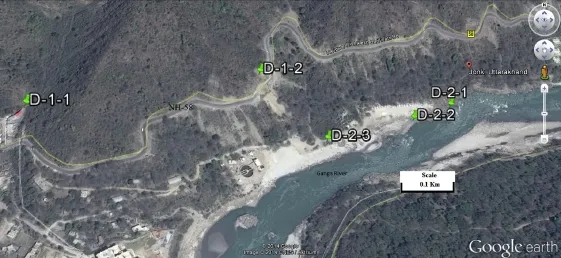
Fig.1.Satellite imagery of 2013 showing investigation area.Five locations are marked with green symbols.
Field investigations have been carried out at fi ve locations to study the natural slope stability and rock mass parameters.Determination of laboratory parameters is a key to these types of researches(Vishal et al.,2011,2012;Sarkar et al.,2012b).Laboratory experiments were also conducted to determine the strength of the samples by Schmidt hammer test according to Brencich et al. (2013)and uncon fi ned compression test.Correlation chart for Schmidt hammer rebound values,rock density,compressive strength and rebound number on smooth surfaces was used to estimate uncon fi ned compressive strength(UCS)(Miller,1965). However,Schmidt values are not reliable because they are only used to correlate with the data obtained from UCS(Bell,2005). Weathering conditions were also determined from slake durability index test to work out“weathering index”given by Goodman (1989).
Rock quality designation(RQD,%)was calculated by fi eld survey using mean discontinuity spacing(Singh and Goel,1999). Kinematic analysis was performed to illustrate the potential for various modes of rock slope failures(plane,wedge,toppling failures)that occur due to the presence of unfavourably oriented discontinuities(Hoek,2007).The analysis was based on Markland’s test as described by Hoek and Bray(1981).According to the Markland’s test,a planar failure is likely to occur when a discontinuity dips in the same direction(within 20°)as the slope face,at an angle less than the slope angle but greater than the friction angle along the failure plane.A wedge failure may occur when the line of intersection of two discontinuities forming the wedge-shaped block plunges in the same direction as the slope face and the plunge angle is less than the slope angle but greater than the friction angle along the failure plane. A toppling failure may happen when a steeply dipping discontinuity is parallel to the slope face(within 30°)and dips into it (Yoon et al.,2002).
4.Results and discussion
Field data recorded in Table 2 were taken from fi ve locations along the NH-58,consisting of two sets ofjoints in Krol A limestone (Fig.2).Orientations of bedding and joints were recorded from the fi eld measurements for 2-3 times,and the average values of orientation,persistence,aperture,fi lling,roughness and water conditions from each location are listed in Table 2.UCS of 25 samples was determined for fi ve locations by plate load test and the results were crosschecked with the correlation chart(Miller,1965). Average values from plate load test were taken into consideration during the rock mass characterisation reported in Table 3.
Degree of weathering plays a signi fi cant role in slope stability. Slake durability test was performed to assess the resistance offered by a rock sample to weakening and disintegration when subjected to two standard cycles of drying and wetting.For rock containing clay minerals,exchange of ions takes place due to adsorption and absorption of water which swells the rock.The slake durability test was performed based on the standards given by Goodman(1989) for weathering,and the percentage obtained after the 1st and 2nd cycles indicates that the area under investigation falls in moderate to high durability for weathering.
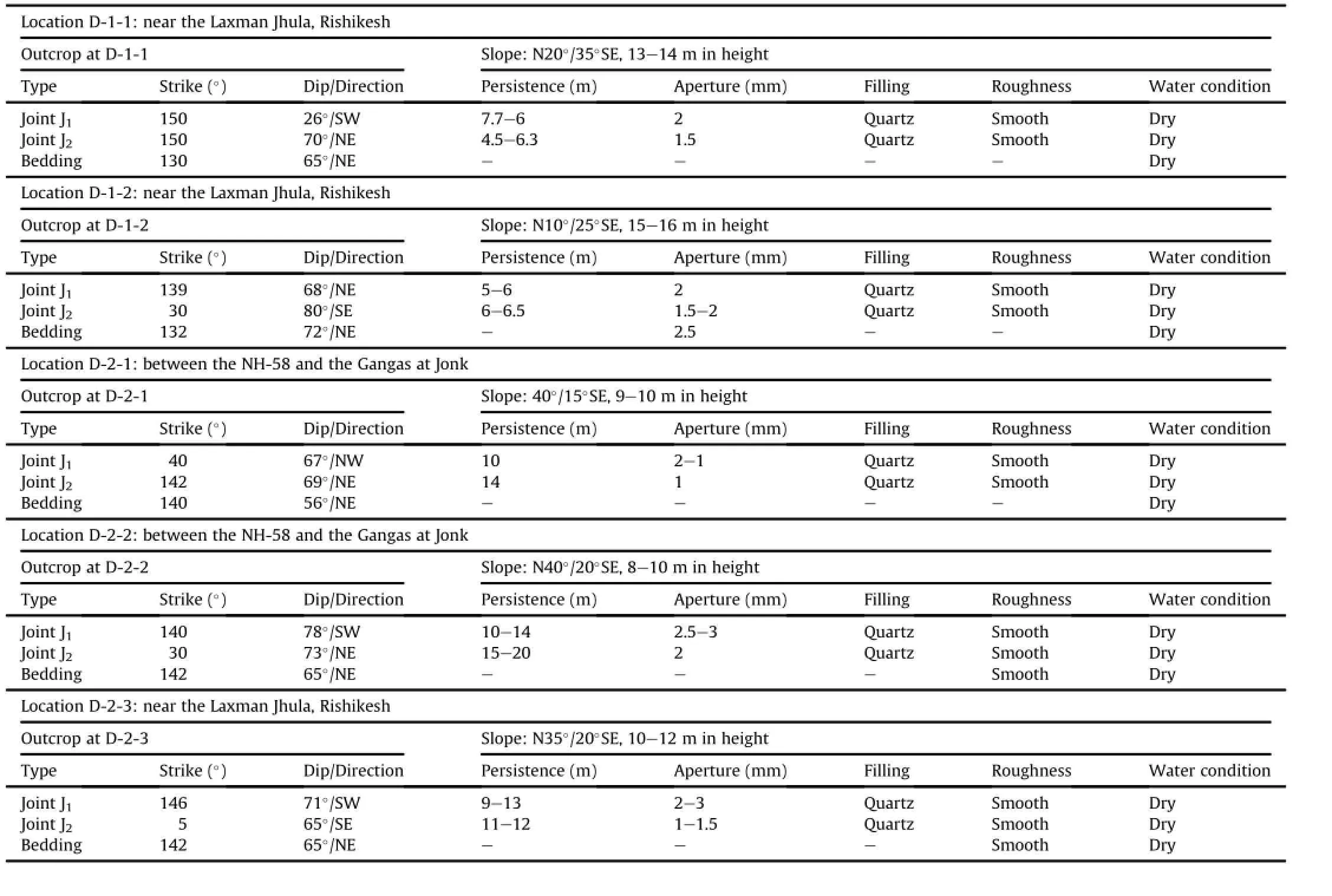
Table 2 Field data obtained from fi ve locations near Rishikesh.
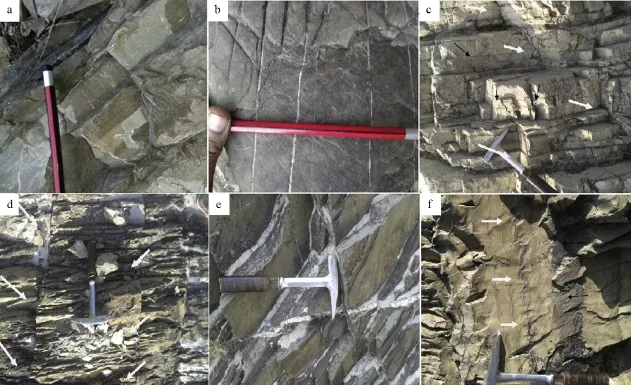
Fig.2.Field photographs:(a)Bedding in Krollimestone as discontinuities along the NH-58 near the Laxman Jhula,Rishikesh;(b)Discontinuities fi lled by secondary materialin Krol limestone along the NH-58 near the Laxman Jhula,Rishikesh;(c)Two sets ofdiscontinuities with horizontaland verticalbedding planes in Krollimestone,respectively,near Jonk between the NH-58 and the Gangas,Rishikesh;(d)Joints in plan view in Krol limestone between the NH-58 near Jonk and the Gangas,Rishikesh;(e)Heavily healed joints fi lled with crystallised calcite in Krol limestone near Jonk;and(f)Solution structure in Krol limestone showing stylolitic joints and plumose markings near Jonk.

Table 3 UCS values for each location by direct and indirect methods.

Table 4 Slake durability indexes for estimating the degree ofweathering of samples.
Chips and small rectangular blocks were taken to conduct the slake durability test.Instead of limestone lithology,weathering condition of rock is good as the limestone at the site is quartzbearing and micritic in nature.Due to the micritic nature,modal analysis during microscopic studies was impossible.The results obtained from slake durability tests(Table 4)indicate that Krol A limestone is resistant to weathering due to its quartz-bearing nature.Photomicrograph was used to con fi rm lithology,i.e.fi negrained micritic limestone with fi ne-grained quartz and argillaceous matter(Fig.3).Thin section studies also con fi rmed the composition of veins seen on the outcrop across the vein in the intact rock where the thin section sample was chipped.
LSS is a national classi fi cation system which was developed by CBRI,Roorkee.This classi fi cation scheme was conducted to correlate the slope grade obtained by SMR.LSS takes overburden, weathering and vegetation density into account to determine slope stability.To analyse the study area in a broad sense and cover more parameters affecting slope stability,LSS was used.Detailed fi eld investigation was performed to calculate LSS values for each location to assign weight to various factors of rock mass reported in Table 5.LSS value for each location ranges from 193 to 246 which categorises the rock mass into moderate vulnerability to landslide. The LSS results show a good correlation with the SMR data.
To assign the weight to different factors ofrock mass,carefuland detailed fi eld investigation was conducted to calculate the LSS value for each location.The average value of LSS is 134.Therefore, the rock mass under investigation has“l(fā)ow susceptibility”to landslide.
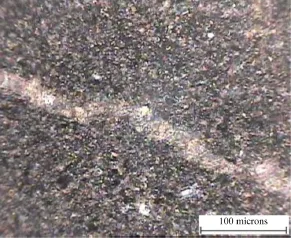
Fig.3.Photomicrograph under X-Nicol showing fi ne-grained quartz-bearing micritic limestone having vein of calcite in Krol A limestone near Rishikesh.
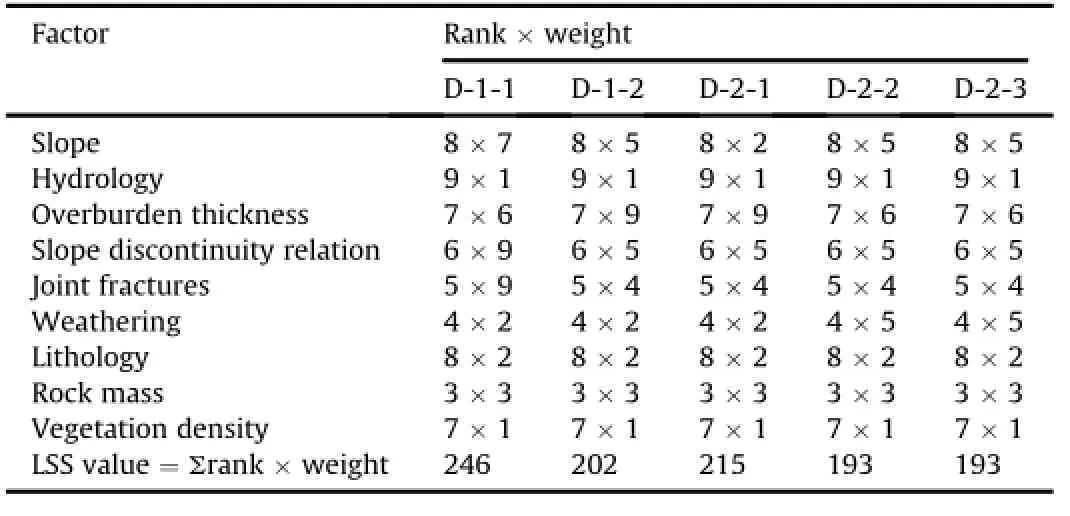
Table 5 LSS values of rock mass along the NH-58 near Jonk,Rishikesh.
RMRBwas calculated within the guidelines of Bieniawski(1979) and the rating values of each parameter are given in Table 6.UCS obtained by uncon fi ned plate load tests ranges from 39 MPa to 48 MPa.RQD values range from 82%to 95%,which were obtained by fi eld survey using graph of mean discontinuity spacing and density as the core samples were not available.Ratings were given according to the average values of mean discontinuity spacing (mm),roughness,separation,continuity and groundwater condition of joints.
RMRBwas calculated on the basis of various rock mass parameters which was further used in the calculation of SMR for all fi ve locations.Average value of RMRBwas taken for location D-2-2 as two RMRBvalues were given due to small variation at the location. F1,F2and F3were calculated on the basis of relative orientation of joints with respect to slope.The value of F4 is equalto 15 as the rock mass under investigation in natural slopes,and no excavation was done earlier.Totalvalue of SMR for both planar failure and toppling failure ranges from 66 to 70 as shown in Table 7.So,rock mass under investigation falls in class 2b according to SMR,which was in stable condition.
Kinematic analysis based on Markland’s test was conducted using internal friction angle of rock,relative orientation of slopes and discontinuities which were measured for 2-3 times to identify any possible structurally controlled failure at locations under investigation.Kinematic analysis ofslopes D-1-1,D-1-2,D-2-1,D-2-2 and D-2-3(Fig.4)reveals that structurally controlled failure will not occur in these slopes.Hence,these sites are safe for the construction of buildings with minor treatment.
5.Conclusions
The study was conducted to identify the safe zones and their vulnerability to sliding and present condition as the Himalayan region is very active.RQD values range from 82%to 95%,showing moderate to high durability to weathering according to slake durability index test.UCSs of intact rock range from 39 MPa to 47 MPa,indicating that the rock is moderately strong.RMR value ranges from 49 to 58 indicating that this rock mass lies in good quality.For the study region,SMR value varies from 66 to 70 indicating that the rock mass is in stable class;and some block failures may occur and require occasionalsupport.These slopes can be supported using various techniques such as nets,spot bolting oranchoring,and systematic shotcrete can also be implemented for supporting the slope.Toe wall can be constructed for extra safety depending upon the requirement of the project.LSS was calculated to crosscheck the results obtained from the SMR and to clarify the effects of certain parameters controlling slope stability which were not considered in SMR.According to LSS,the rock mass falls in the category of low to moderate vulnerability to landslide as LSS value ranges from 193 to 246.Kinematic analysis of slopes at different locations under study indicates that slopes are stable and no failure is observed.Therefore,during the whole fi eld and laboratory investigations,the rock mass along the NH-58 near Jonk,Rishikesh, falls in partly stable condition and suitable reinforcement can prevent the slope from mass wasting processes.

Table 6 RMRBrating values of rock mass along the NH-58(Bieniawski,1979).

Table 7 SMR values along the NH-58 near Jonk,Rishikesh(Romana et al.,2003).
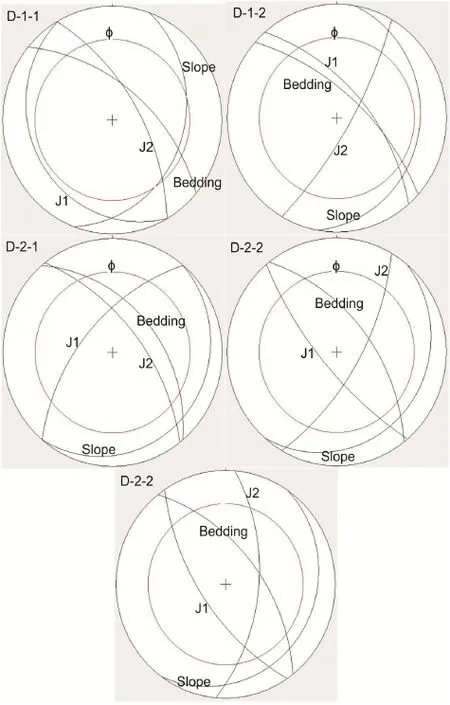
Fig.4.Stereographic projection of fi ve locations under investigation near Jonk,Rishikesh.
Con fl ict of interest
The authors wish to con fi rmthat there are no known con fl icts of interest associated with this publication and there has been no signi fi cant fi nancial support for this work that could have in fl uenced its outcome.
Acknowledgements
The fi rst three authors thank the Chairman of Department of Geology and Department of Civil Engineering,Aligarh Muslim University,Aligarh,India for providing necessary facilities to carry out this work.
Bell FG.Engineering geology.2nd ed.Oxford,UK:Elsevier;2005.
Bieniawski ZT.The geomechanics classi fi cation in rock engineering applications.In: Proceedings of the 4th Congress of the International Society of Rock Mechanics, vol.2,Montreux,Switzerland.Rotterdam:A.A.Balkema;1979.p.41-8.
Brencich A,Cassini G,Pera D,Riotto G.Calibration and reliability of the rebound (Schmidt)hammer test.Civil Engineering and Architecture 2013;1(3):66-78.
Goodman RE.Introduction to rock mechanics.2nd ed.Wiley;1989.
Gupte SS,Singh R,Vishal V,Singh TN.Detailinvestigation of stability of in-pit dump slope and its capacity optimization.International Journal of Earth Sciences and Engineering 2013;6(2):146-59.
Hoek E.Practical rock engineering.2007.https://www.rocscience.com/documents/ hoek/corner/Practical-Rock-Engineering-Full-Text.pdf.
Hoek E,Bray JW.Rock slope engineering.London:Institution of Mining and Metallurgy;1981.
Indian Standard Code 11315.Methods for the quantitative description of discontinuities in rock mass.Part-2,part-3,part-4,part-5,part-6,part-7.1987.
Jiang G,Christie-Blik N,Kaufman AJ,Banerjee DM,Rai V.Sequence stratigraphy of the neoproterozoic infra Krolformation and Krolgroup,Lesser Himalayas,India. Journal of Sedimentary Research 2002;72(4):524-42.
Miller RP.Engineering classi fi cation and index properties for intact rock.PhD Thesis.Urbana,USA:University of Illnious;1965.
Pradhan SP,Vishal V,Singh TN.Stability of slope in an open cast mine in Jharia coal fi eld,India-a slope mass rating approach.Mining Engineers Journal 2011;12(10):36-40.
Pradhan SP,VishalV,Singh TN,Singh VK.Optimisation ofdump slope geometry visà-vis fl yash utilisation using numerical simulation.American Journal of Mining and Metallurgy 2014;2(1):1-7.
Romana M.New adjustment ratings for application of Bieniawski classi fi cation of slopes.In:Proceedings of the International Symposium on Role of Rock Mechanics.Zacatecas,Mexico;1985.p.49-53.
Romana M,Seron JB,Montalar E.SMR geomechanics classi fi cation:application, experience and validation.In:ISRM 2003-technology roadmap for rock mechanics.South African Institute of Mining and Metallurgy;2003.
Sarkar K,Vishal V,Singh TN.An empirical correlation of index geomechanical parameters with the compressional wave velocity.Geotechnical and Geological Engineering 2012b;30(2):469-79.
Sarkar S,Kanungo DP,Kumar S.Rock mass classi fi cation and slope stability assessment of road cut slopes in Garhwal Himalaya,India.Geotechnical and Geological Engineering 2012a;30(4):827-40.
SatiSP,SundriyalYP,Rana N,Dangwal S.Recent landslides in Uttarakhand:nature’s fury or human folly.Current Science 2011;100(11):1617-20.
Srivastava HB,Sinha LK,Katiyar V.Mesoscopic structures from the area around Satengal,Lesser Garhwal Himalaya.Journal of Scienti fi c Research,Banaras Hindu University,Varanasi 2011;55:25-34.
Singh B,Goel RK.Rock mass classi fi cation:a practicalapproach in civilengineering. Elsevier;1999.
Singh TN,Verma AK,Sarkar K.Static and dynamic analysis of a landslide.Geomatics,Natural Hazards and Risk 2010;1(4):323-38.
Singh TN,Gulati A,Dontha L,Bhardwaj V.Evaluating cut slope failure by numerical analysis-a case study.Natural Hazards 2008;47(2):263-79.
Singh TN,Pradhan SP,Vishal V.Stability of slope in a fi re prone opencast mine in Jharia Coal fi eld,India.Arabian Journal of Geosciences 2013;6(2):419-27.
Trivedi R,Vishal V,Pradhan SP,Singh TN,Jhanwar JC.Slope stability analysis in limestone mines.International Journal of Earth Sciences and Engineering 2012;5(4):759-66.
Valdiya KS.The making of India:geodynamic evolution.MacMillan Publishers; 2010.
Vishal V,Das R,Singh TN.Investigating the frictional response of granitic rock surface:an experimental approach.Journal of the Geological Society of India 2012;80(4):493-8.
Vishal V,Pradhan SP,Singh TN.Instability analysis of mine slope by fi nite element method approach.International Journal of Earth Sciences and Engineering 2010;3(6):11-23.
Vishal V,Pradhan SP,Singh TN.Tensile strength of rock under elevated temperatures.Geotechnical and Geological Engineering 2011;29(6):1127-33.
Vishal V,Pradhan SP,Singh TN.Analysis of stability of slopes in Himalayan terrane along national highway:109,India.In:Engineering geology for society and territory,vol.1;2015.p.511-5.
Yoon WS,Jeong UJ,Kim JH.Kinematic analysis for sliding failure of multi-faced rock slopes.Engineering Geology 2002;67(1-2):51-61.

Mr.Tariq Siddiqueis a Ph.D.candidate in the Department of Earth Sciences,Indian Institute of Technology Roorskee, India.Presently,he is working on the slope stability assessment of road cut slopes along the national highway (NH-58)from Rishikesh to Devprayag,a partof the Lesser Himalayas.He has two publications accepted on the slope stability investigation in the Journal of Geological Society of India.He has presented a paper on Recent Developments and Challenges in Earth Sciences in a National Seminar under UGC DRS-SAP,at Department of Geology,Aligarh Muslim University,India.He has worked on the project entitled“Reservoir Characterisation of Sandstone”during his summer internship at Oiland NaturalGas Corporation (ONGC),Dehradun,India.He has undergone training in an off-campus Outreach programme on Remote Sensing,GIS and Global Navigation Satellite System conducted by Indian Space Research Organization(ISRO)under the Department of Space,Government of India.He has participated in an Industry-Academia Workshop on Recent Trends in Oiland Gas Drilling Technology conducted by ONGC, Dehradun,India.He has been awarded by the two gold medals for outstanding performance and securing highest marks in his post graduate studies at Aligarh Muslim University,India.

Dr.M.Masroor Alamis an Associate Professor in the Department of Civil Engineering,Aligarh Muslim University,Aligarh.His fi eld of interest includes sedimentology, engineering geology and disaster management.He is involved in many geotechnical investigations and has carried out consultancy work related to geological investigation of dam-reservoir sites.He has published more than twenty research papers in national and international journals and has one book titled“Fundamentals of Engineering Geology and Geoengineering”to his credit.He has completed research project as PI,funded by Department of Science and Technology,Government of India, on Malani Volcaniclastics in 2006.Presently,he is one of the Co-Opt Researcher of 1.63 Crore,Central Power Research Institute,Bangalore,India funded project.He is on Editorial Panel of Oxford India Publications,Chennai.

Dr.M.E.A.Mondalis a professor in Aligarh Muslim University.He has carried out 06 research projects and at present carrying out 01 research project sponsored by Department of Science and Technology,Ministry of Science and Technology,Government of India and University Grants Commission,New Delhi.To date,Dr.Mondal has published more than 57 papers in peer reviewed journals including Precambrian Research,Gondwana Research,Lithosphere,Tectonophysics,Island Arc,Journal of Asian Earth Sciences,Geochemical Journal,Terra Nova.Total citation of his papers is 250.He is fellow and life member of many learned bodies and has been a member of National Working Group for International Geological Correlation Programmes(IGCP 510,IGCP 599).

Dr.Vikram Vishalis an Assistant Professor in the Department of Earth Sciences,Indian Institute of Technology(IIT)Roorkee,India and presently visiting Stanford University(USA)as a Fulbright-Nehru Postdoctoral Fellow. He obtained a Ph.D.degree jointly from IIT Bombay(India) and Monash University(Australia).He is a recipient of the National Geosciences Award-Young Researcher by the Government of India,the Young Scientist Award by the Indian Science Congress Association and Dr.Coggin Brown Memorial Award from the Mining,Geological and Metallurgical Institute of India,Kolkata.He holds to his credit a totalof42 publications on different domains ofengineering geology,geomechanics and petrophysics in various journals,book chapters and conference proceedings of repute.He is investigating three research projects funded by the Ministry of Science and Technology by the Government of India.
*Corresponding author.Tel.:+91 789 5454 791,+91 1332 285097.
E-mail addresses:vik12fes@iitr.ac.in,vikram12july@gmail.com(V.Vishal).
Peer review under responsibility of Institute of Rock and Soil Mechanics,Chinese Academy of Sciences.
1674-7755?2015 Institute of Rock and Soil Mechanics,Chinese Academy of Sciences.Production and hosting by Elsevier B.V.All rights reserved.
http://dx.doi.org/10.1016/j.jrmge.2015.06.007
 Journal of Rock Mechanics and Geotechnical Engineering2015年5期
Journal of Rock Mechanics and Geotechnical Engineering2015年5期
- Journal of Rock Mechanics and Geotechnical Engineering的其它文章
- Microseismic monitoring and numerical simulation on the stability of high-steep rock slopes in hydropower engineering
- Investigation of meso-failure behaviors of Jinping marble using SEM with bending loading system
- Regressive approach for predicting bearing capacity of bored piles from cone penetration test data
- Prediction ofroadheaders’performance using arti fi cialneuralnetwork approaches(MLP and KOSFM)
- Experimental study of polyurethane foam reinforced soil used as a rock-like material
- Computing in-situ strength of rock masses based upon RQD and modi fi ed joint factor:Using pressure and damage sensitive constitutive relationship
